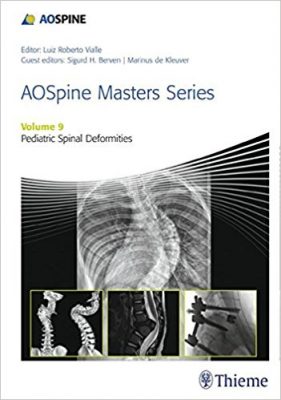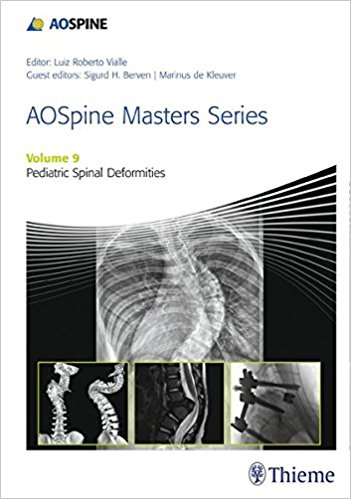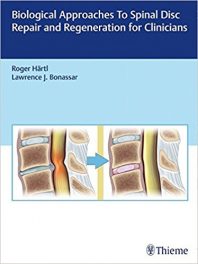 (Volume 9 in the AOSpine Masters Series)
(Volume 9 in the AOSpine Masters Series)
Editors: Luiz Roberto Vialle, MD; Sigurd H. Berven, MD; and Marinus de Kleuver, MD
Publisher: Thieme – 192 pagesBook Review by: Nano Khilnani
This book and other volumes in the AOSpine Masters Series offers:
- Clinical wisdom
- Latest diagnostic tips and tools
- Pathology-focused expert insight and advice of experts worldwide
- Operative and non-operative treatment options
- Reference sources
- Up-to-date research
This particular one provides an overview of early-onset scoliosis, adolescent idiopathic scoliosis and related conditions such as spondylolysis and spondylolisthesis, including their classifications and natural histories, available general and specific knowledge on pediatric spinal deformities, non-operative management options, and the latest surgical procedures and techniques.
Forty-one specialists in orthopedics and orthopedic surgery, neurosurgery, pediatrics, spine deformities and surgery, and related fields, wrote the 17 chapters of this book. They are from all over the United States and 12 other countries – Australia, Brazil, Canada, China, France, Hong Kong, Japan, the Netherlands, Puerto Rico, Thailand, Turkey, and West Africa.
We list below the titles of this book’s chapters to provide you an overview of its contents:
- Early-Onset Scoliosis: Classification and Natural History
- Adolescent Idiopathic Scoliosis: Classification and Natural History
- Preoperative Evaluation and Imaging Techniques in Adolescent Idiopathic Scoliosis
- Late Sequelae of Untreated Pediatric Deformity
- Surgical Techniques for the Management of Early-Onset Scoliosis
- Surgical Techniques for Adolescent Idiopathic Scoliosis and the Selection of Fusion Levels
- Novel Nonfusion Growth-Modulating Techniques for Pediatric Scoliosis
- Long-Term Outcomes of Operative Management in Adolescent Idiopathic Scoliosis
- Revision Pediatric Spinal Deformity Surgery
- Spondylolisthesis: Classification and Natural History
- Adolescent Spondylolisthesis Associated with Scoliosis: Which Condition Should Surgery Address?
- Pediatric Spondylysis and Spondylolisthesis
- Dysplastic High-Grade Spondylolisthesis
- Kyphotic Deformity in the Pediatric Spine
- Spine Surgery in the Developing World
- Safety and Complications in Pediatric Surgery
- Measuring Outcomes in Pediatric Spinal Deformity
One of the types of spinal deformities covered in this book is kyphosis. While the upper back or thoracic region of the spine is supposed to have a slight natural curve, a kyphotic spine is excessively curved on the back, frequently just below the head. Such a condition is also called a roundback or hunchback.
Looked at from the side, people who have a kyphotic spine have noticeably rounded shoulders and / or or protruding back, and appear to be slouching. Kyphosis can lead to excessive pressure on the spine, causing pain and sometimes breathing difficulties due to pressure on the lungs.
While kyphosis can be caused by scoliosis or spinal curvature, other causes are: aging, arthritis, injury to the spine, muscle weakness, osteoporosis, Scheuermann disease, or slipped discs.
Kyphosis in elderly women is known as dowager’s hump but it can affect people of any age. Rarely does it occur in newborns. However it does affect children, particularly those who are 10 year old or over, as discussed in chapter 14 – Kyphotic Deformity in the Pediatric Spine.
The authors of this chapter point out that the severity of the curve in a kyphotic deformity varies depending on the age of the child. A number of other conditions could also be present in the presenting patient along with kyphosis, including intraspinal abnormalities and neuromuscular disorders.
What needs to be looked at to determine the appropriate treatment for a particular kyphosis case, are factors such as axial skeletal dynamics, congenital anomalies, concurrent pathologies, developmental patterns, dynamics of growth in the developing spine, etiologies, infections, neoplastic processes (sometimes), skeletal dysplasia, and surgical sequelae, all of which and more, are covered in this chapter.
Scheuermann disease, named after Holger Scheuermann in 1921 after he described it as less correctable than the postural roundback, has been found to be the most common cause of kyphosis in adolescents.
The treatment regimen for Scheuermann disease (kyphosis in adolescents) is primarily a set of non-operative options that includes bracing, casting, exercise, and medications. Adolescents with kyphosis of less than 60 degrees are treated with physical therapy and exercise programs until they reach skeletal maturity. Bracing and casting measures have resulted in as much as a 40 percent decrease in kyphosis.
This is an important book on pediatric spinal deformities, including those found in adolescents. It is well illustrated with images, particularly radiographs.
Series Editor:
Luiz Roberto Vialle, MD, PhD is Professor of Orthopedics in the Spine Unit of the School of Medicine at Cajuru University Hospital, and Medical Director of the Human Tissue Bank at the Catholic University of Parana State in Curitiba, Brazil.
Guest Editors:
Sigurd H. Berven, MD is Professor in Residence and Chief of Spine Service in the Department of Orthopedic Surgery at the University of California San Francisco in San Francisco, California.
Marinus de Kleuver, MD, PhD is Professor and Chairman of the Department of Orthopedics at Radbaud University Medical Center in Nijmegen, Netherlands.







